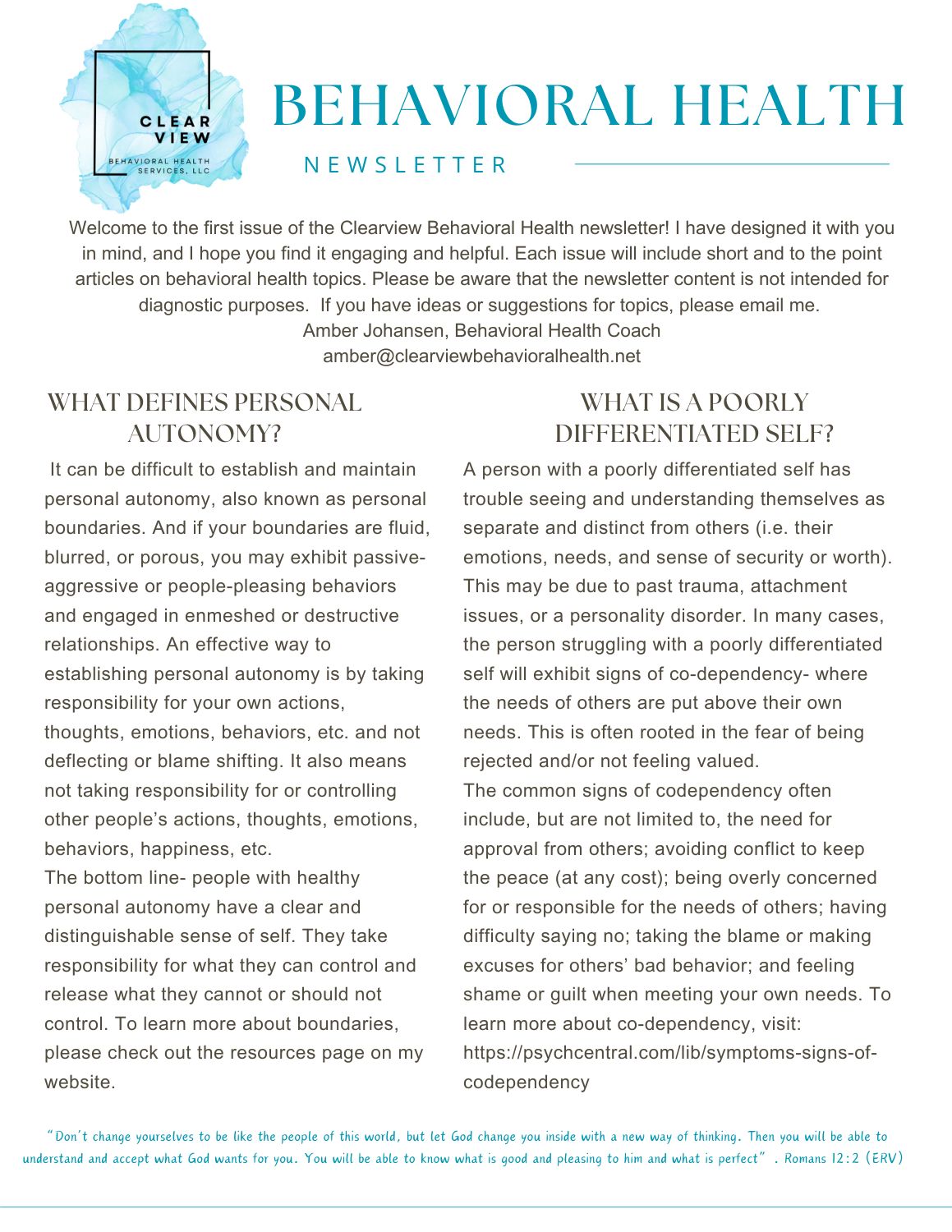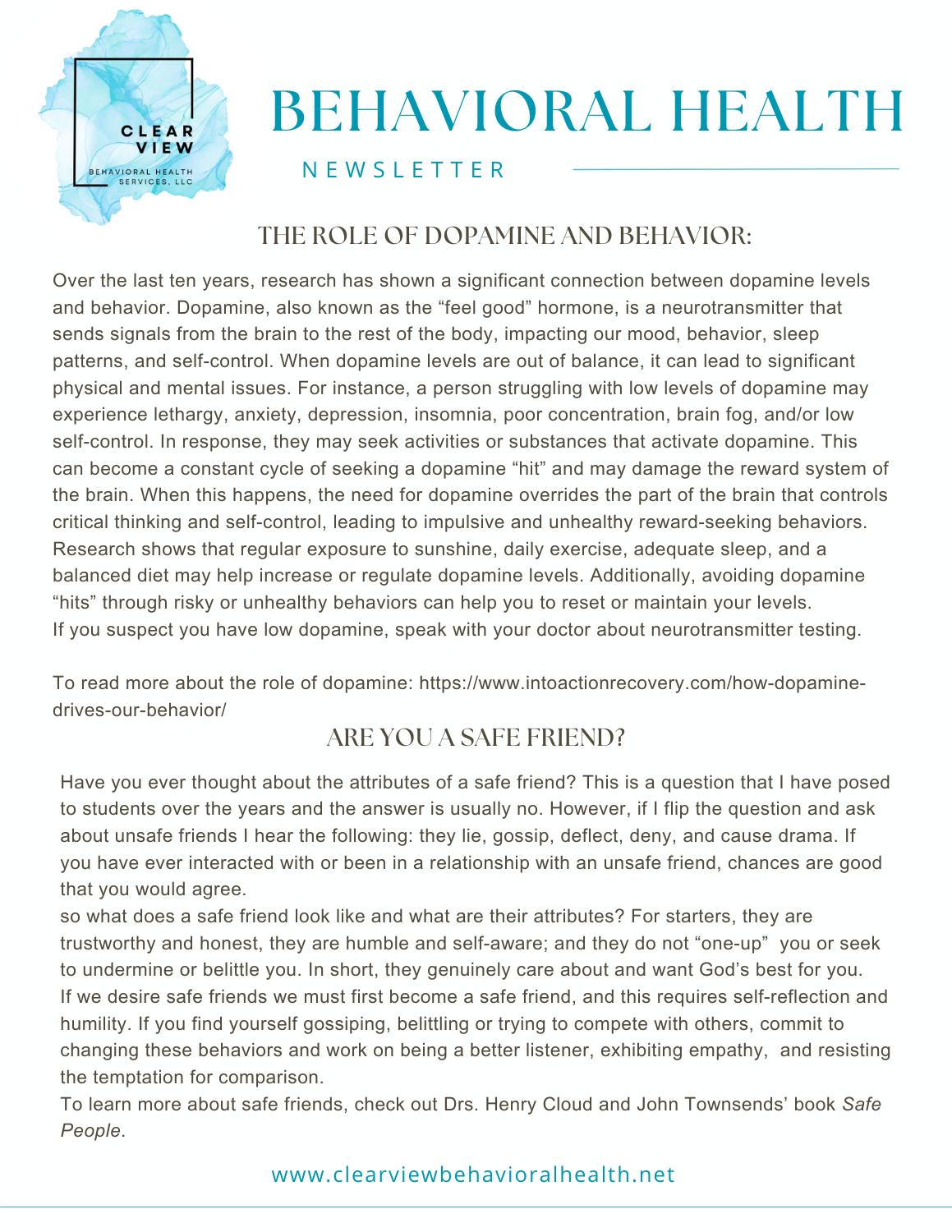
Tips and Strategies for improving your life
Tips for Processing and Integrating Feelings of Disappointment
By Amber Johansen, BCC

As a behavioral health coach, one of the most challenging aspects of helping others navigate change is guiding them toward mature thinking and better self-awareness. Without this foundation, managing feelings can become difficult, if not impossible. In this blog, we will explore ways to effectively manage the emotion of disappointment and move to a more balanced and healthier frame of mind.
What is Disappointment?
Disappointment is an emotional response to unmet expectations or desires. When tied to high anticipation, it often leads to feelings of sadness, frustration, and discouragement. For instance, someone may feel disappointed if they do not receive a promotion after working hard and preparing well or if they were planning for a vacation but had to cancel because of sickness. In both of these scenarios, there was build up and then let down, and how we handle these experiences can be the difference between resolved and unresolved emotions.
What is Emotional Integration?
Emotional integration is a balanced emotional state where a person can experience both positive and negative emotions without being overwhelmed or controlled by them. In contrast, a fragmented emotional state leaves individuals unable to process and hold their feelings, leading to overwhelming experiences. Being able to integrate and reconcile emotions is the foundation of mature thinking and fragmented responses are often associated with immature or undeveloped emotional states.
Why is Emotional Integration Necessary and Healthy?
When a person can reconcile both negative and positive emotional experiences, they respond to situations more adaptively, demonstrating resilience. Without this ability, negative emotions may be suppressed or pushed away, leading to unresolved feelings.
What Happens if Negative Emotions Are Not Integrated?
While emotions such as disappointment, frustration, sadness, hostility, disgust, fear, and envy are typically considered negative, they can provide important signaling about unmet or unreasonable needs and confused boundaries. Though these feelings can be uncomfortable, denying or deflecting them often results in unhealthy coping mechanisms. For example, someone feeling disgust might lash out in anger and temporarily alleviate the emotional overwhelm, but this prevents genuine emotional processing and resolving of feelings.
1. Expect Negative Experiences and Emotions
This crucial first step is often the most difficult. Embedded in
expectation and anticipation is the belief that the experience will turn out as
you have desired. The build up to this and then the letdown causes the disappointed
and sadness that follows. This is why it is important to have a consistent mindset
of accepting that negative experiences happen. By holding this frame of mind,
you are managing expectations.
2. Accept Negative Experiences and
Emotions
Failing to process negative emotions often results in unhealthy responses such
as denying, deflecting, blaming, and catastrophizing. Each of these reactions
reflects a lack of emotional maturity:
Denying and deflecting are unhealthy coping mechanisms that result from feeling overwhelmed or unable to tolerate the discomfort. This “stuffing” and/or “pushing away” of emotions, causes the person to ignore the negative experience and emotions, which leads to bitterness, anger, resentment, and other unresolved emotions.
Blaming is another unhealthy coping mechanism that involves shifting negative emotions onto others. This reaction is often due to being overwhelmed and/or controlled by the emotion and acting to shift the emotion away. This too can cause unresolved emotions.
Catastrophizing is the tendency to exaggerate negative outcomes, causing anxiety and overreactions. Reflecting on questions like “How do I know the results will be what I expect?” can help challenge these thoughts.
3. Reframe the Experience
Reframing allows you to view the situation from different perspectives and
consider alternative outcomes. When you do this, you are creating opportunities
to grow and learn from the experience. This in fact, one of the most effective
ways to build emotional maturity and resilience.
4. Reconcile the Emotion
Reconciling emotions means resolving them rather than letting them linger. This
involves experiencing disappointment without blaming others or entering crisis
mode and accepting it as part of the human experience. Success in this step is
indicated by the ability to tolerate negative emotions without resorting to
deflection, lashing out, or catastrophizing.
Dear God, Thank you for hearing my prayers and loving me no matter the circumstances. In moments of disappointment and unmet expectations, help me to accept these experiences and resist the urge to lash out or blame others. Help me to trust you as you guide me in finding lessons in each challenge. Thank you for your unwavering love and mercy as I navigate these emotions. In Jesus' name. Amen.
How to offer support in a time of crisis or suffering
By Amber Johansen, BCC

Helping a loved one in crisis can be difficult, and finding the right words may cause us to unintentionally distance ourselves emotionally or say the wrong thing. With that in mind, I’m offering a few suggestions for responding in a supportive and helpful way. Keep in mind that these are general guidelines and may not apply to every situation. However, they can help you express empathy, consideration, and encouragement in a healthy, constructive way.
Defining a Crisis
A crisis is a state of instability or danger that leads to a significant change or emotional upheaval. It is usually triggered by unforeseen events like health issues, accidents, death, or natural disasters, and is marked by fear, instability, and change.
Understanding Empathy
Empathy is the ability to understand and share someone else's feelings by imagining yourself in their situation. When we empathize, we offer meaningful support. Without empathy, we risk being less considerate or, worse, adding to the pain the person is already feeling.
How to Enter Someone's Experience
A good example of empathy can be seen in the story of Job from the Old Testament. Job loses everything—his children, property, possessions, and health. His friends come to comfort him:
"Now when Job’s three friends heard of all this adversity that had come upon him, each one came from his own place; for they had made an appointment together to come sympathize with him and to comfort him. When they looked from a distance and did not recognize him because of his disfigurement, they raised their voices and wept; and each one tore his robe in grief and threw dust over their heads in sorrow. So they sat down on the ground with Job for seven days and seven nights, and no one spoke a word to him, for they saw that his pain was very great." —Job 11:13
From this, we can learn three key things about empathy:
They Go to Him: Love is an action. Job’s friends showed their love by being physically present. While this isn't always possible, we can still "be there" through phone calls, texts, or emails.
They Enter His Grief and Sorrow: Job's friends acknowledged both his physical pain and his emotional suffering. Today, we can do this by offering a simple hug or saying, "I’m so sorry this has happened" or "My heart is breaking for you."
They Sit With Him in Silence: Job’s friends didn’t try to offer advice or look on the bright side. Instead, they sat with him, understanding that there were no words that could help at that moment. We can offer similar support by being present, listening, and checking in, showing patience, love, and compassion.
As the story of Job unfolds, his friends begin questioning the circumstances of his suffering and become unsupportive, critical, and argumentative. In fact, Job refers to them as "miserable comforter". With this in mind, let's talk about how to encourage and support others in constructive ways.
How to Offer Encouragement and Support Constructively
Recognize Your Limits Concerning Negative Emotions: If you struggle with processing negative emotions, it’s okay to communicate this to your friend without making it about you. You can say, “I care deeply about you, and I’m really sorry for what you’re going through. I sometimes struggle with processing tough emotions, but I want to be here for you in any way I can.”
Maintain Healthy Boundaries: It’s important not to own their experience. While it might feel natural to offer solutions or observations, be sure to ask for permission: “May I offer a suggestion?” or “Can I share an observation?” If the answer is no, respect it.
Avoid Toxic Positivity: Comments like “It could be worse” or “Everything happens for a reason” can be incredibly harmful. Also, avoid sharing personal stories that shift the focus away from their pain. The goal is to acknowledge their feelings, not dismiss or minimize them.
Remain Patient: In long-term suffering, we may experience compassion fatigue. It’s important to be self-aware, set boundaries, and seek support when needed to avoid burnout. A trusted friend or counselor can help you navigate these emotions.
Be an Encouragement: During a crisis, people often feel helpless and hopeless. While it’s important to sit with them in their suffering, you also need to be aware if they become stuck in self-pity. Offer encouragement by saying, “I can imagine you’re feeling overwhelmed. How can I support you?” This keeps the conversation empathetic while gently offering a path forward.
In closing, my purpose in writing this is to encourage you (and myself) to push through the uncomfortable self-doubt that comes with supporting others in their suffering and to offer a few suggestions on how to navigate these difficult experiences. The bottom line is to extend love by offering words of encouragement, compassion, hope.
This is an excerpt of a text. It was sent to someone who is fighting cancer by one of her closest friends. It's a wonderful example of speaking life and hope into a scary and exhausting circumstances:
I am in awe of your strength and ability to stay focused on [God] sustaining you through these beyond difficult stretches of your journey. You are truly an amazing warrior...I see [God's] strength being made perfect in your weakness...I know you are feeling weary, but I see strength. Know that I am praying for your spirit as much as your physical needs.
Whether you are twenty-five or fifty-five, chances are you have been in a situation or relationship where you have exhibited immature emotional responses. This may be due to inadequate response skills, an inability to reflect and replace, or stunted emotional growth. Many of us were not taught appropriate conflict resolution skills or had parents who modeled poor or destructive behaviors. However, this does not mean we are stuck in the same response cycles with no opportunity to change.
Sometimes, our immature emotional responses are triggered by a hurt, fear, or threat perceived during the interaction, causing us to go into fight, flight, freeze, or fawn mode. These responses may impact your marriage, children, aging parents, siblings, or co-workers and building skills for healthier responses may vastly improve these relationships.
Let’s explore unhealthy patterns of behavior, the causes, and ways to grow emotionally. Note that these steps are general suggestions for awareness, reflection, and growth and are not designed for diagnosing or treating emotional patterns related to mental illness, addiction, or abuse. If you are experiencing any of these, please seek help immediately.
The first step, is to identify the behaviors-especially repeated patterns- so that you can replace them with healthier responses. The following are examples of immature responses:
1. Emotional manipulation- Pouting, sulking, and the silent treatment.
2. Reactive responses- Ranting, lashing out, aggression, name-calling.
3. Poor impulse control- Quick escalation of emotions.
4. Lack of responsibility- Deflecting, blaming, and gaslighting.
1. Lack of conflict resolution skills-Growing up in a family where you were not allowed to experience negative emotions, express your likes and dislikes, or differentiate from your parent’s values.
2. Past trauma- Experiencing trauma in childhood may result in emotional stunting, and regression patterns.
3. Hurt, fear, threat- Perceiving situations or experiences as hurtful, scary, or threatening (real or otherwise).
1. Reflect- Think about and write down past and recent patterns of responses in situations where you felt hurt, fear, or threat; determine if there are patterns in the interactions and responses.
2. Name the patterns- Use the four patterns of behaviors listed above as references (include responses that may not be listed).
3. Acknowledge- Take responsibility for these behaviors while also having compassion and patience for yourself.
4. Talk with a trusted person- Ask them for feedback on your reflections and patterns.
5. Integrate-Consider alternative behaviors to be integrated into your response patterns.
6. Reframe and replace-This step may take time to implement. It involves taking responsibility, reducing impulsivity, remaining reflective, and considering alternate responses.
If you are responding from a place of trauma or lack of conflict resolution skills, this step is critical for emotional maturity. These skills require practice and build on each other as you work to integrate new patterns of responding.
Example Scenario: Discussing finances with your spouse.
Reflect: Notice unhealthy patterns of response when you have these conversations.
Name the patterns: Quick escalation of emotions, ranting, and lashing out.
Acknowledge- Accept these patterns of behaviors and consider alternative responses.
Talk: Discuss your responses with a trusted friend or counselor.
Integrate: Plan for how to respond and set boundaries before the discussion.
Reframe and replace: Reframe the conversation as one where you and your spouse work together for solutions. Discuss possible triggers and replace threatening or hurtful language with supportive and instructive language.
1. Pause: Take a moment before responding.
2. Consider: Think about the circumstances, the other person’s perspective, and response options.
3. Respond: Be aware of your tone and body language. Communicate if you need a break before responding.
4. Reflect: Think about how you responded and consider integrating this behavior in other circumstances
5. Revise: If you revert back to an old pattern, extend grace to yourself, apologize and respond appropriately.
“I hear what you are saying and it’s important to me, but I need a few minutes to calm down/process/consider how to respond appropriately. I appreciate your patience with me.”
“I am sorry for how I responded earlier. I was feeling (hurt, afraid, threatened) because I felt (give reason). Please give me an opportunity to revise my response.”
These steps are suggestions for improving your response to conflict and are not exhaustive. They aim to promote self-awareness, self-ownership, and a willingness to improve interactions with others. If you have trouble with these exercises or experience anxiety or depression during the process, please consider seek help from a counselor, pastor, or therapist.
Additional resource on emotional maturity: https://www.verywellmind.com/signs-of-emotional-maturity-7553316
To read Amber's parenting blog, please click here


